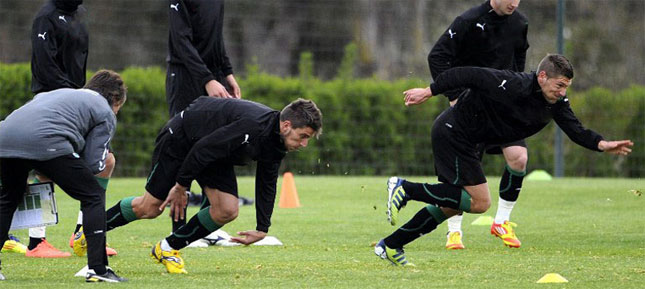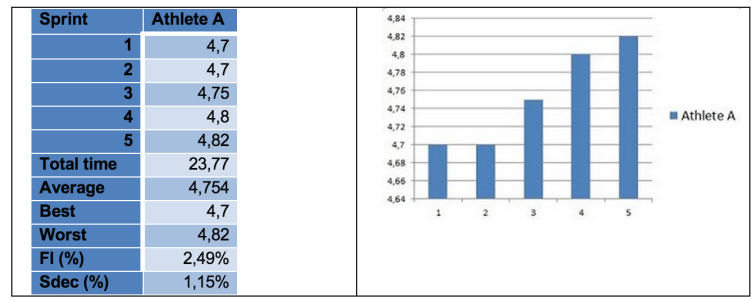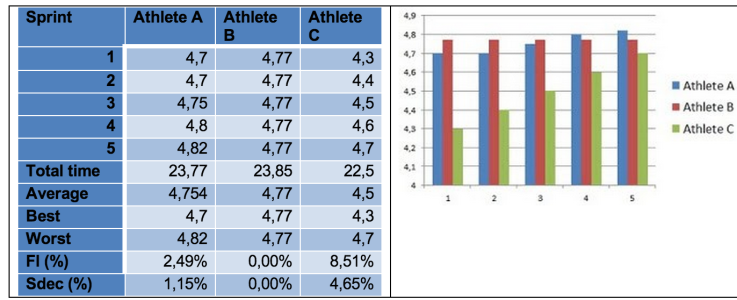Troubles With Repeated-Sprint-Ability
I was just finishing reading great review paper(s) on Repeated-Sprint-Ability by Girard, Bishop and Mendez-Villanueva.
Girard O, Mendez-Villanueva A, Bishop D. Repeated-sprint ability – part I: factors contributing to fatigue. Sports Med. 2011 Aug 1;41(8):673-94.
Bishop D, Girard O, Mendez-Villanueva A. Repeated-Sprint Ability – Part II: Recommendations for Training. Sports Med. 2011 Sep 1;41(9):741-56.

Mentioned papers are great up-to-date review of the current knowledge on RSA testing and training. Here are some quotes from the papers:
For example, the limited evidence to date suggests that, compared with repeated- or intermittent-sprint training, interval training produces superior increases in both βmin vitro [27] and Na+/K+ pump isoform content.[12] With respect to RSA, repeated-sprint training has been reported to produce greater improvements in best sprint time[12,27,96] and mean sprint time,[4,12,27,96] compared with interval-based training. In contrast, interval training appears to be superior to repeated-sprint training to decrease (i.e. improve) the sprint decrement score (or the fatigue index).[12,27] However, due to the problems associated with interpreting changes in the sprint decrement score when there are concurrent changes in best sprint time,[102] it is difficult to make universal recommendations.
Thus, it appears that while interval training may be superior at minimizing the decrement during repeated sprints (possibly due to greater physiological adaptations, as outlined in section 2), intermittent- or repeated-sprint training is superior at improving the performance of individual sprints. As a result, the combination of the two (i.e. repeated-sprint training to improve sprint performance plus interval training to improve the recovery between sprints) may be the best strategy to improve RSA. Further research is required to investigate the optimal volume and duration of a repeated-sprint training macro cycle, as anecdotal evidence suggests that too much repeated-sprint training is stressful and may lead to decreases in RSA.
Despite the obvious need of more research in this area, these results seem to confirm that in well trained team-sport athletes, maximization of mean repeated-sprint time is linked to improvements in single-sprint performance.[33]
This review has highlighted that there is not one type of training that can be recommended to best improve RSA and all of the factors believed to be responsible for performance decrements during repeated-sprint tasks
While different training strategies can be used in order to improve each of these potential limiting factors, and in turn RSA, the concurrent implementation of different forms of training may be the best strategy to improve RSA
Nonetheless, two key recommendations can be made based on the existing literature as follows: 1. It is important to include some training to improve single-sprint performance. This should include (i) specific sprint training; (ii) strength/power training; and (iii) occasional high-intensity(>VO2max) training (e.g. repeated, 30-second, allout efforts separated by ~10 minutes of recovery) to increase the anaerobic capacity. 2. It is also important to include some interval training to best improve the ability to recover between sprints (if the goal is to improve fatigue resistance). High-intensity (80–90% VO2max) interval training, interspersed with rest periods (e.g.1 minute) that are shorter than the work periods (e.g. 2 minutes) is efficient at improving the ability to recover between sprints by increasing aerobic fitness (VO2max and the lactate threshold), the rate of phosphocreatine resynthesis and βmin vitro
What I wanted to rant about in this blog entry are not the training implications (which are mentioned in the quotes above, but I will deal with them in another blog entry), but rather assessment and evaluation of RSA performance. What is better and what is worse? How do we evaluate the RSA performance?
There are couple of methods to evaluate the RSA performance. Suppose we have an athlete that did 5x30m runs with 25sec jog back recovery. His times are as follows:

From the mentioned data we are going to calculate Total Time (basic sum of all sprints), Average Time, Fatigue Index (FI) and Percentage Decrement Score (Sdec). If you are interested how is this calculated please check the mentioned papers, but to understand what I want to argue you don’t basicaly need to know.
So, this Athlete A shows certain pattern of fatigue (shown by FI and Sdec) as the sprints repeat. Let’s introduce Athlete B.

What we can see in the case of Athlete B is that he has great ability to repeat the sprints without fatigue (as shown by zero score in his FI and Sdec ). His first sprint was slower, but he maintained it across sprints.
Let me introduce Athlete C.

The Athlete C has the fastest first sprint, but he fatigues as hell across the sprints (as shown by his FI and Sdec).
Now the main question: Who has better Repeated-Sprint-Ability? Athlete A, B or C? Who would you like in your team? If this is all one athlete, would you like his RSA progress from A to B, or from A to C over time? Why?
If we take FI and Sdec as an indice of RSA ability, then Athlete B would be our best bet. But hell, he has „Repeated-Slow-Ability“ (TM) as my brother-in-arms Carl Valle would say. He is slow as hell. Look at his average and total time – they are worst from the three.
Let me tell you straight. I would choose Athlete C to be in my team. His first sprint is way better than of other two, his total time is better, his average time is better. His last sprint is faster than first sprints of other two guys, even if his FI and Sdec are worst.
So what is a indicator of RSA? Ability to recover between slow sprints? Ability to repeat crap power output? I see a lot of athletes and their coaches with crap power output and speed/acceleration working on their RSA. What exactly do they want to be able to repeat? Repeated-
Slow-Ability?
The point being taken here is that we need to see the whole picture. Usual indicator of RSA are FI and Sdec, but hopefully you now see they don’t tell the whole story. If the Athlete C improve both FI and Sdec over time, his RSA will improve. But we cannot compare athletes solely based on FI and Sdec without taking Total Time, Best time and Average into account as well. Just compare Athlete B and Athlete C.
Now return to the quotes from the article one more time. Especially this one:
Despite the obvious need of more research in this area, these results seem to confirm that in well trained team-sport athletes, maximization of mean repeated-sprint time is linked to improvements in single-sprint performance.[33]
So, me as a coach want a freaking powerful and quick athlete that is able to produce great single-sprint performance FIRST before I start to be concerned with his RSA. A lot of soccer coaches work on RSA performance, but look at those sprint numbers. They are CRAP. I don’t want my athletes have great FI and Sdec and crap first sprint. I want them to be more like an Athlete C. I will deal with RSA later.
Regarding training, please read the quotes again. Certain pattern emerges (as sumarized in the last quote) – interval training seems to improve FI and Sdec (recovery between sprints), while repeated-sprint training seems to improve performance of individual sprints (and as concesquence Total Time and Average Time). But what is the latter RSA training is changed for real speed/power training? Would it yield better effects on RSA indices?
To date, we are unaware of research that has investigated the influence of ‘traditional’ sprint
training on RSA. However, it is possible that such training may produce even better improvements in both best sprint time and mean sprint time,[86] and further research is warranted
Well, maybe we have pushed RSA training drills way over the border. Maybe we don’t need to do more that occasional RSA training sessions („..as anecdotal evidence suggests that too much repeated-sprint training is stressful and may lead to decreases in RSA”) if we do quality strength, power, speed and interval (VO2max) training session? Maybe RSA (training) is over-rated?











Responses